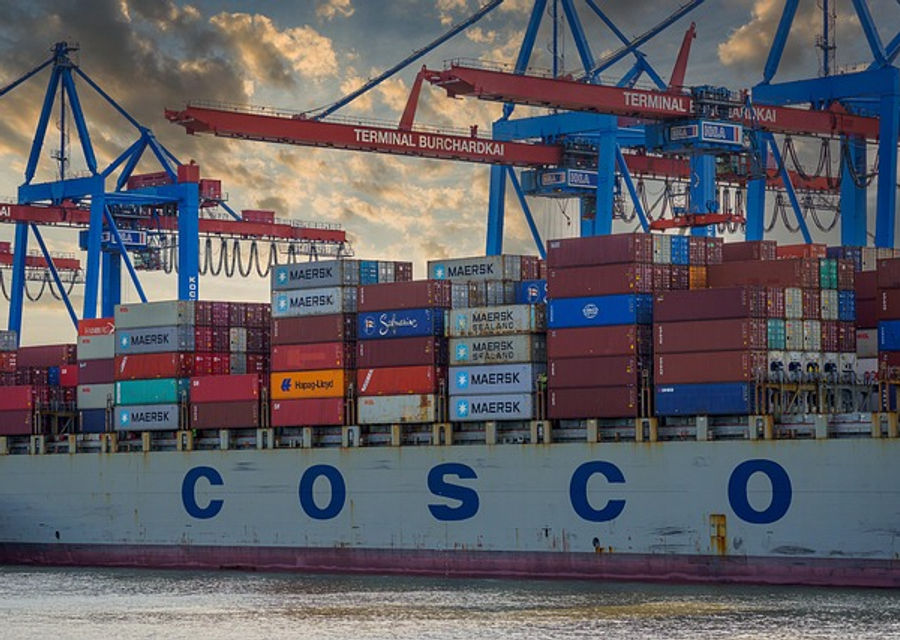Surging US Container Imports: Trends and Tariff Impact
- THE MAG POST

- Aug 12
- 11 min read

The recent surge in US container imports highlights the dynamic nature of global trade. In July, containerized imports nearly broke records, driven by seasonal demand and tariff anxieties. China's import volumes rebounded significantly, influencing overall figures. Trade policies, especially tariffs, play a crucial role, prompting strategic frontloading by importers. Ports like Miami and Houston saw substantial gains, reflecting shifts in container flows. As you read on, you'll discover how these trends shape the future of US container imports.
The latest data reveals a compelling narrative about the flow of goods into the United States, particularly concerning US container imports. Containerized imports through U.S. ports experienced a significant surge, exceeding 2.6 million twenty-foot equivalent units (TEUs) in July, driven by peak-season demand and anxieties surrounding potential tariffs. This robust volume nearly matched the all-time monthly record, underscoring the resilience and adaptability of the global supply chain amidst economic uncertainties. The increase highlights the strategic maneuvers of importers as they navigate shifting trade policies and prepare for potential cost increases, ensuring a steady flow of goods to meet consumer demand. The performance of US container imports is a key indicator of economic health and trade dynamics, reflecting both opportunities and challenges in the global marketplace.
Analyzing the Surge in US Container Imports
The surge in US container imports can be attributed to several factors, including strong seasonal demand and strategic frontloading by importers anticipating trade policy changes. The report by Descartes Datamyne highlighted that the total volume reached 2,621,910 TEUs, marking an 18.2% increase from June and a 2.6% rise compared to July of the previous year. This figure fell just short of the record set in May 2022, signaling a near return to peak import levels. The relatively mild port transit delays, despite the sharp increase in import volumes, indicate that the existing infrastructure is capable of handling elevated volumes, a testament to ongoing improvements and efficiencies in port operations. Understanding these dynamics is crucial for businesses and policymakers alike, as they seek to optimize supply chain strategies and ensure economic stability. The US container imports data provides valuable insights into the interplay between trade policies, seasonal demands, and infrastructure capabilities.
The resurgence of China's import volumes through major American ocean container gateways is a noteworthy aspect of the US container imports narrative. In July, China's imports soared to 923,075 TEUs, a remarkable 44.4% increase compared to the previous month, reaching the highest level since January. This surge elevated China's share of U.S. imports to 35.2%, up from 28.8% in June, although still below the 41.5% peak observed in February 2022. This recovery underscores the continued importance of China as a key trading partner for the United States, despite ongoing trade tensions and diversification efforts. The fluctuations in China's import volumes reflect the sensitivity of trade flows to geopolitical factors and policy changes. Analyzing these trends in US container imports helps stakeholders anticipate and adapt to evolving trade dynamics, ensuring resilience in their supply chain operations.
Trade policies, particularly tariffs, are significantly influencing US container imports. The Trump administration's decision to end the de minimis exemption, which previously allowed imports under $800 to enter duty-free, has added pressure on importers. The uncertainty surrounding tariffs and the anticipation of flat-rate fees ranging from $80 to $200 per item for less expensive imports have prompted importers to accelerate shipments. Additionally, the impending expiration of the 30% temporary tariff rate on Chinese imports in mid-October has further incentivized frontloading. These factors highlight how policy decisions can directly impact import volumes and trade flows. Businesses must remain vigilant and proactive in monitoring these policy changes to mitigate potential disruptions and optimize their supply chain strategies. The dynamics of US container imports are increasingly shaped by the interplay between economic factors and trade policy decisions.
The imposition of tariffs ranging from 10% to 41% by the U.S. on August 1, affecting over 60 countries, including the European Union, Canada, Japan, and South Korea, further complicates the landscape of US container imports. India, facing a 25% levy starting August 7, and a universal duty of 50% on copper, are also impacted by these measures. These tariffs, designed to protect domestic industries and address trade imbalances, can lead to increased costs for importers and consumers, potentially altering trade patterns. The increase of US container imports demonstrates how businesses are trying to get ahead of these tariffs. Monitoring the effects of these tariffs on trade volumes and prices is essential for understanding the broader economic implications and for businesses to adapt their strategies accordingly. The evolving trade policy environment continues to be a critical factor shaping the dynamics of US container imports.
Port Performance and US Container Imports
A comparative analysis of container volume growth relative to pre-COVID levels provides valuable insights into the structural changes in import demand. The report indicated that container volumes have increased by 19.3% compared to July 2019, suggesting a long-term structural growth in import demand. This growth underscores the sustained need for efficient port operations and infrastructure to handle the increasing flow of goods. Furthermore, the 18.2% increase in import volumes in July, reaching 404,235 TEUs from June, surpassed the 11.2% month-over-month gain observed in 2023, marking the strongest monthly increase since early 2021. This data reinforces the notion that tariff timing, rather than just seasonal demand cycles, is increasingly influencing US container imports. Understanding these trends is vital for policymakers and businesses to make informed decisions about infrastructure investments and supply chain management.
The performance of the top 10 U.S. ports offers a detailed perspective on the distribution and handling of US container imports. These ports collectively experienced a 20.4% month-over-month improvement in container volumes, representing a net gain of 379,578 TEUs. This growth was distributed across both West Coast and East/Gulf Coast ports, indicating a balanced increase in import activity across the country. Miami emerged as the leading port with a 35.5% monthly improvement, followed by Houston (34.2%), Oakland (31.3%), and Savannah (25.2%). The busiest U.S. gateways, Long Beach and Los Angeles, saw increases of 24.1% and 18.0%, respectively, while New York-New Jersey recorded a 14.7% gain, and Charleston and Norfolk each grew by 12%. Tacoma's volumes increased by a more modest 1.7%. These figures highlight the diverse performance of different ports and the evolving dynamics of US container imports.
Several factors, including punitive fees on China-linked vessels and strategic supply chain adjustments, are reshaping container flows and port activity related to US container imports. The impending implementation of punitive fees on China-linked vessels is prompting some shipping lines to redistribute tonnage, potentially impacting container flows. Carriers are increasingly bypassing secondary ports, and shippers are leveraging transshipments through alternative hubs to reconfigure their supply chains. Despite the robust increase in July, China imports remain 9.8% below the all-time high of 1,022,913 TEUs recorded in July 2023. These strategic shifts underscore the adaptability of the shipping industry in response to regulatory changes and economic pressures. Understanding these dynamics is crucial for ports and businesses to optimize their operations and maintain competitiveness in the evolving landscape of US container imports.
A comprehensive analysis of product categories provides insights into the composition of US container imports and potential shifts in sourcing strategies. The broad recovery across various product categories suggests that long-term sourcing shifts are still in progress. Furniture and bedding, plastics, and machinery remain the top three categories by volume, accounting for over 38% of China-origin TEUs. Other significant segments include toys and sporting goods, electric machinery, and vehicles and parts. These categories reflect the diverse range of goods imported into the U.S. and the ongoing reliance on China as a major supplier. Monitoring these trends is essential for businesses to understand the evolving demand for different product categories and to adjust their sourcing strategies accordingly. The composition of US container imports provides valuable insights into the broader economic trends and consumer preferences.
The outlook for US container imports remains uncertain due to elevated tariffs, intensified customs enforcement, and the recent imposition of a 40% U.S. tariff on transshipped exports from Vietnam. These factors create a complex and unpredictable trade environment. The report suggests that without a significant tariff rollback or a broader trade agreement, China's share of U.S. containerized trade may face renewed pressure. Imports from China have shown substantial increases at the top 10 U.S. ports, with an overall gain of 262,126 TEUs, representing a 42.9% month-over-month increase. Houston led all ports with a 122% spike, followed by Savannah (90.2%), New York-Newark (69.5%), Charleston (78.9%), Norfolk (51.4%), and Oakland (53.9%). The U.S. ports closest to China, Los Angeles (33.6%) and Long Beach (26.7%), also experienced strong recoveries. These trends underscore the ongoing adjustments in trans-Pacific routing strategies in response to fluid policy signals.
Impact of Tariffs on US Container Imports
The impact of tariffs on US container imports is a multifaceted issue, influencing not only the volume of goods entering the country but also the strategic decisions of importers and the overall dynamics of global trade. Tariffs, whether imposed on specific countries or product categories, create a ripple effect throughout the supply chain. Importers often respond by accelerating shipments to avoid impending tariffs, a practice known as frontloading, which can lead to temporary surges in import volumes. Additionally, businesses may seek alternative sourcing locations to mitigate the impact of tariffs, potentially shifting trade patterns and altering the composition of US container imports. Understanding these dynamics is crucial for policymakers and businesses to assess the effectiveness of tariff policies and to adapt their strategies accordingly.
The end of the de minimis exemption, which previously allowed imports under $800 to enter duty-free, has had a notable impact on US container imports. This exemption provided a significant advantage for small-value shipments, particularly in the e-commerce sector. The removal of this exemption means that these shipments are now subject to duties and taxes, increasing the cost of importing these goods. As a result, importers may need to reassess their sourcing strategies and consider consolidating shipments to reduce costs. The impact of this policy change is particularly significant for businesses that rely heavily on small-value imports, potentially leading to changes in the types of goods and the sources from which they are imported. Monitoring these shifts is essential for understanding the evolving landscape of US container imports and the broader implications for the economy.
The strategic adjustments made by shipping lines in response to punitive fees on China-linked vessels are reshaping the landscape of US container imports. With the impending implementation of these fees, shipping lines are reevaluating their routes and tonnage allocations. Some carriers are opting to bypass secondary ports, concentrating their operations in larger, more efficient hubs. Additionally, shippers are increasingly leveraging transshipments through alternative ports to avoid the fees and maintain competitive pricing. These adjustments highlight the adaptability of the shipping industry in response to regulatory changes and economic pressures. Understanding these dynamics is crucial for ports and businesses to optimize their operations and maintain competitiveness in the evolving landscape of US container imports. The strategic responses to these fees are indicative of the broader trends shaping global trade flows.
The shifts in sourcing strategies, driven by tariffs and other trade policy changes, are evident in the evolving composition of US container imports. While furniture and bedding, plastics, and machinery remain the top three categories by volume, the relative importance of different product categories is subject to change. As businesses seek alternative sourcing locations and adjust their supply chains, the mix of goods imported into the U.S. may shift. For example, increased tariffs on certain products from China may lead to higher imports of those same products from other countries. Monitoring these shifts is essential for understanding the evolving demand for different product categories and for businesses to adapt their sourcing strategies accordingly. The composition of US container imports provides valuable insights into the broader economic trends and consumer preferences.
The overall outlook for US container imports is characterized by uncertainty, driven by a combination of factors including elevated tariffs, intensified customs enforcement, and evolving trade policies. The imposition of tariffs on a wide range of goods and countries has created a complex and unpredictable trade environment. The potential for further policy changes, such as additional tariffs or trade agreements, adds to this uncertainty. Businesses must remain vigilant and proactive in monitoring these developments to mitigate potential disruptions and optimize their supply chain strategies. The future of US container imports will depend on the interplay between these factors and the ability of businesses and policymakers to adapt to the evolving trade landscape.
Future Trends in US Container Imports
The integration of technology and automation is poised to revolutionize US container imports, enhancing efficiency, transparency, and resilience in the supply chain. Technologies such as blockchain, artificial intelligence (AI), and the Internet of Things (IoT) are being increasingly adopted to streamline operations, improve visibility, and reduce costs. Blockchain technology can provide a secure and transparent platform for tracking goods and managing documentation, while AI can be used to optimize logistics and predict potential disruptions. IoT devices can provide real-time data on the location and condition of goods, enabling better monitoring and control. These technological advancements have the potential to transform the way US container imports are managed, making the supply chain more efficient and responsive to changing market conditions.
The growing emphasis on sustainability and environmental responsibility is influencing the future of US container imports. Consumers and businesses are increasingly demanding more sustainable products and practices, leading to a greater focus on reducing the environmental impact of shipping and logistics. This includes efforts to reduce carbon emissions, minimize waste, and promote the use of eco-friendly materials. Shipping companies are investing in more fuel-efficient vessels and exploring alternative fuels, while ports are implementing measures to reduce pollution and improve energy efficiency. Additionally, businesses are seeking to optimize their supply chains to reduce transportation distances and minimize their carbon footprint. The drive towards sustainability is likely to play an increasingly important role in shaping the future of US container imports, encouraging more environmentally responsible practices.
The evolving geopolitical landscape and trade relations will continue to exert a significant influence on US container imports. Trade agreements, tariffs, and other policy changes can have a direct impact on the flow of goods and the strategic decisions of importers. As countries seek to diversify their trade relationships and reduce their reliance on specific suppliers, the composition of US container imports may shift. Geopolitical tensions and conflicts can also disrupt supply chains and create uncertainty for businesses. Monitoring these developments and adapting to the changing geopolitical landscape is essential for maintaining a resilient and competitive supply chain. The future of US container imports will be shaped by the interplay between economic factors and geopolitical forces.
The changing consumer preferences and demand patterns are also shaping the future of US container imports. As consumer tastes evolve and new products emerge, the types of goods imported into the U.S. will change. The growth of e-commerce has led to an increase in small-value shipments and a greater demand for faster delivery times. Additionally, there is a growing demand for personalized and customized products, requiring more flexible and responsive supply chains. Businesses must stay attuned to these changing consumer preferences and adapt their sourcing and logistics strategies accordingly. The future of US container imports will be driven by the evolving needs and expectations of consumers.
The development of infrastructure and port capacity is crucial for accommodating the increasing volume of US container imports. As import volumes continue to grow, ports and transportation networks must be upgraded to handle the increased traffic. This includes investments in new terminals, deeper channels, and more efficient rail and road connections. Additionally, there is a need for better coordination and integration between different modes of transportation to ensure a seamless flow of goods. The development of infrastructure and port capacity is essential for maintaining the competitiveness of US container imports and supporting economic growth. These investments will help to reduce congestion, improve efficiency, and ensure that the supply chain can meet the demands of a growing economy.






















































Comments